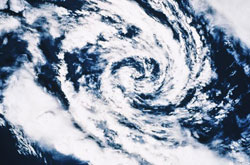You are here: Home › Stressors › Extreme Natural Events
Extreme Natural Events Research
Issue

Extreme natural events such as hurricanes and “red tides” or Harmful Algal Blooms (HABs) can pose particular risks to coastal oceans and communities. Better forecasting and monitoring methods are critical to protecting human health and lives and to lessening the trauma to coastal communities. Strong winds and waves associated with storms, for instance, can degrade habitats by altering freshwater flow and nutrient concentrations. They can also lead to more pollution as a result of increased runoff. Storms appeared to have a significant effect on the Gulf of Mexico hypoxic zone. CSCOR's GoMEX program sponsored researchers in Louisiana that found the hypoxic “dead zone” to be half the size of the usual summer average for the past ten years, likely the result of two large storms that recently had passed through the area. In addition, a team of NOS-supported scientists worked to improve ecological forecasting capabilities, leading in 2003 to the first-ever NCCOS forecast of the dead zone off the Louisiana and Texas coasts. These recent ecological modeling improvements have also indicated that nutrient load reductions beyond those suggested by the current Action Plan for Reducing, Mitigating, and Controlling Hypoxia in the Northern Gulf of Mexico may be necessary to achieve the management goal of reducing the dead zone by two-thirds. These new modeling capabilities are examples of the leading edge of ecological forecasting, a growing NOAA capability critical to coastal management decisions..
Weather also may influence the frequency, severity, and duration of HABs due to the increase in nutrient runoff from land. These events occur in the waters of nearly every coastal and Great Lakes state, and HABs have been responsible for an estimated $1 billion in economic losses over the past few decades. Furthermore, HABs can damage the health of people and marine organisms and harm local and regional economies. These blooms have decimated the scallop fishery in Long Island’s estuaries (see Brown Tide Fact Sheet) and have led to seasonal closures of various shellfisheries on Georges Bank, from North Carolina to Louisiana, and throughout the Pacific Northwest. They may also have contributed to deaths of hundreds of manatees in Florida, sea lions in California, and other marine mammals, including dolphins in the Northern Gulf of Mexico. HABs have also caused significant respiratory and other illnesses in coastal residents and vacationers. CSCOR's improved methods for forecasting and monitoring for HABs and other extreme natural events are protecting human health and lessening the trauma that coastal communities experience.

